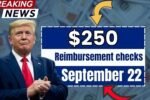$1,702 Stimulus Payment: The U.S. government has approved a targeted stimulus payment of $1,702 to help eligible Americans manage ongoing financial pressures. This relief package aims to provide short-term support as the country continues to deal with inflation, high living costs, and economic recovery. Millions of Americans are expected to receive this payment, which will be automatically sent by the IRS to those who qualify.
Why the Government Is Sending Stimulus in August 2025
Inflation and rising costs continue to outpace wages and savings for many U.S. households. Although the economy has shown some signs of recovery, everyday Americans are still feeling the strain — from higher grocery bills to expensive rent. To counter this, the government authorized this one-time payment to help people cover essential expenses and reduce financial stress heading into the final quarter of the year.
Who Qualifies for the $1,702 Payment?
Eligibility is mainly based on income reported in your most recent tax returns. Most single filers earning less than $75,000 annually and married couples filing jointly with incomes under $150,000 will qualify. Those receiving Social Security, SSDI, or VA benefits may also be eligible, even if they didn’t file a tax return. The IRS will use your 2023 or 2024 tax information to determine your status automatically.
When Will the $1,702 Stimulus Be Sent?
The $1,702 payments are expected to be sent out beginning in early to mid-August 2025. The IRS will likely release payments in phases, as it has done in previous rounds of stimulus. Those enrolled in direct deposit will likely receive their funds first, followed by mailed paper checks and prepaid debit cards for others.
How Will You Receive the Payment?
If you’ve previously received your tax refund or other stimulus checks through direct deposit, your $1,702 payment will arrive in the same way. For those without direct deposit information on file, the IRS will send a paper check or a prepaid debit card to your most recent mailing address. It’s crucial to make sure your contact details with the IRS are current to avoid delays.
Do You Need to Apply for This Stimulus?
In most cases, no application is necessary. If you’ve filed your taxes for 2023 or 2024, or if you receive federal benefits, the IRS will issue the payment automatically. However, if you haven’t filed taxes and don’t receive government benefits, you may need to register through a special IRS portal if one becomes available.
What Makes the $1,702 Amount Significant?
The amount of $1,702 was calculated based on economic data tied to inflation, average household needs, and federal relief budget constraints. While it’s not intended to provide long-term financial support, it’s aimed at covering key expenses for one month — such as rent, groceries, or utility bills — giving families some breathing room in a tough economy.
Will There Be More Payments in 2025?
As of now, the $1,702 payment is a one-time initiative with no formal announcements about follow-up payments. However, lawmakers and economists continue to monitor economic indicators. If inflation rises sharply again or recession fears grow, there’s always the possibility of additional federal support in late 2025 or early 2026.
Frequently Asked Questions ($1,702 Stimulus Payment)
Q1. Is this payment from the federal government?
Yes, the $1,702 stimulus is a federal initiative administered by the IRS.
Q2. Do I need to apply to get it?
No. If you’re eligible and have filed your taxes, the payment will be sent automatically.
Q3. What if I didn’t file taxes recently?
You may still qualify if you receive federal benefits. If not, the IRS may offer a registration portal for non-filers.
Q4. When exactly will it arrive?
The first payments are expected to be issued in August 2025, likely starting mid-month.
Q5. Can I track the payment?
The IRS is expected to offer a tracking tool, similar to the “Get My Payment” portal used during past stimulus rounds.




